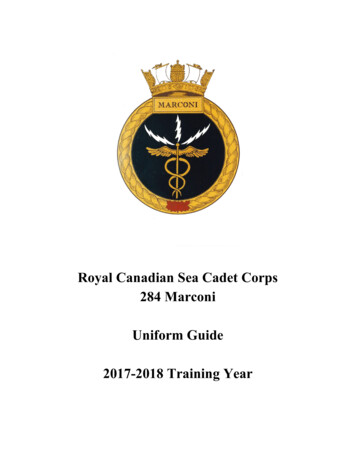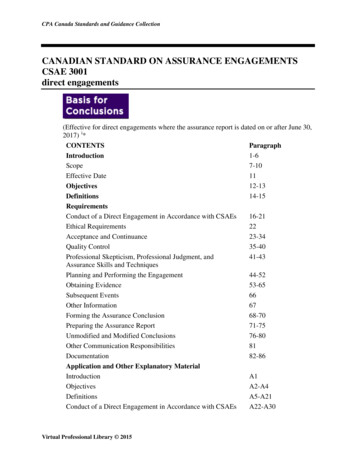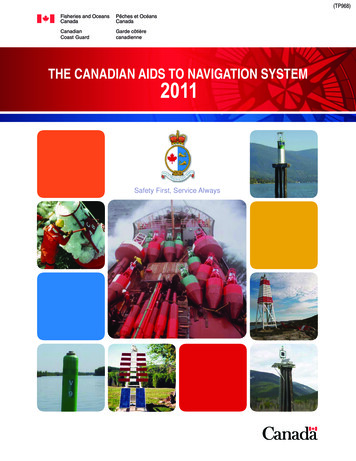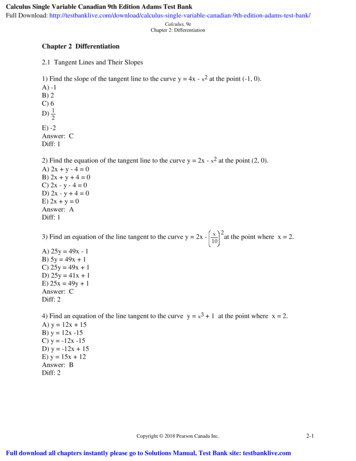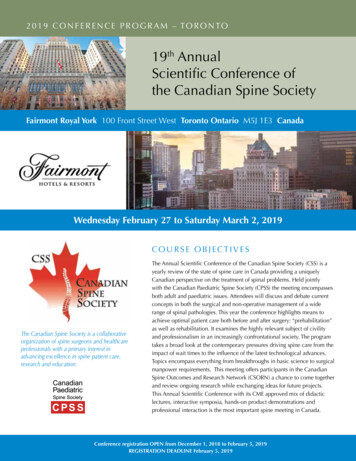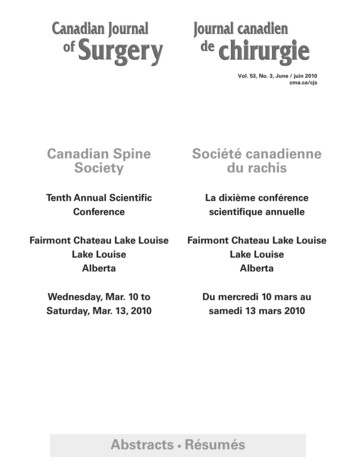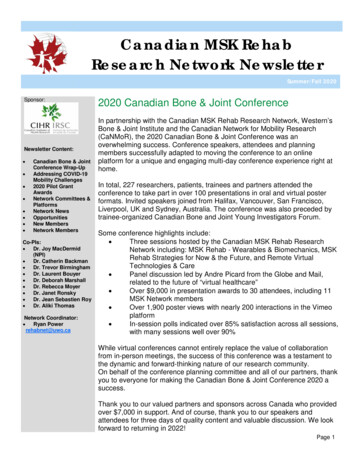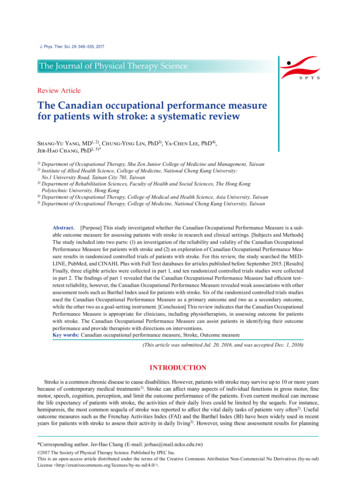
Transcription
J. Phys. Ther. Sci. 29: 548–555, 2017The Journal of Physical Therapy ScienceReview ArticleThe Canadian occupational performance measurefor patients with stroke: a systematic reviewShang-Yu Yang, MD1, 2), Chung-Ying Lin, PhD3), Ya-Chen Lee, PhD4),Jer-Hao Chang, PhD2, 5)*1)Department of Occupational Therapy, Shu Zen Junior College of Medicine and Management, TaiwanInstitute of Allied Health Science, College of Medicine, National Cheng Kung University:No.1 University Road, Tainan City 701, Taiwan3) Department of Rehabilitation Sciences, Faculty of Health and Social Sciences, The Hong KongPolytechnic University, Hong Kong4) Department of Occupational Therapy, College of Medical and Health Science, Asia University, Taiwan5) Department of Occupational Therapy, College of Medicine, National Cheng Kung University, Taiwan2)Abstract. [Purpose] This study investigated whether the Canadian Occupational Performance Measure is a suitable outcome measure for assessing patients with stroke in research and clinical settings. [Subjects and Methods]The study included into two parts: (1) an investigation of the reliability and validity of the Canadian OccupationalPerformance Measure for patients with stroke and (2) an exploration of Canadian Occupational Performance Measure results in randomized controlled trials of patients with stroke. For this review, the study searched the MEDLINE, PubMed, and CINAHL Plus with Full Text databases for articles published before September 2015. [Results]Finally, three eligible articles were collected in part 1, and ten randomized controlled trials studies were collectedin part 2. The findings of part 1 revealed that the Canadian Occupational Performance Measure had efficient test–retest reliability, however, the Canadian Occupational Performance Measure revealed weak associations with otherassessment tools such as Barthel Index used for patients with stroke. Six of the randomized controlled trials studiesused the Canadian Occupational Performance Measure as a primary outcome and two as a secondary outcome,while the other two as a goal-setting instrument. [Conclusion] This review indicates that the Canadian OccupationalPerformance Measure is appropriate for clinicians, including physiotherapists, in assessing outcome for patientswith stroke. The Canadian Occupational Performance Measure can assist patients in identifying their outcomeperformance and provide therapists with directions on interventions.Key words: Canadian occupational performance measure, Stroke, Outcome measure(This article was submitted Jul. 20, 2016, and was accepted Dec. 1, 2016)INTRODUCTIONStroke is a common chronic disease to cause disabilities. However, patients with stroke may survive up to 10 or more yearsbecause of contemporary medical treatments1). Stroke can affect many aspects of individual functions in gross motor, finemotor, speech, cognition, perception, and limit the outcome performance of the patients. Even current medical can increasethe life expectancy of patients with stroke, the activities of their daily lives could be limited by the sequels. For instance,hemiparesis, the most common sequela of stroke was reported to affect the vital daily tasks of patients very often2). Usefuloutcome measures such as the Frenchay Activities Index (FAI) and the Barthel Index (BI) have been widely used in recentyears for patients with stroke to assess their activity in daily living3). However, using these assessment results for planning*Corresponding author. Jer-Hao Chang (E-mail: jerhao@mail.ncku.edu.tw) 2017 The Society of Physical Therapy Science. Published by IPEC Inc.This is an open-access article distributed under the terms of the Creative Commons Attribution Non-Commercial No Derivatives (by-nc-nd)License http://creativecommons.org/licenses/by-nc-nd/4.0/ .
interventions has some limitations. For instance, structured questions in these measures often ignore individual differences,and these measures are not patient-centered assessments. These tools had certain difficulty to detect individual functionalperformance and performance components4). Furthermore, some functional performance levels cannot be examined bythese structured assessments, and the results may not be useful for patients. Patient-centered therapy has been promoted foryears in the rehabilitation field. The rehabilitation experts emphasized the benefits of adapting a patient-centered outcomemeasure for patient assessment5). The patient-centered outcome measure should be used across multidiscipline, includingphysiotherapists.The Canadian Occupational Performance Measure (COPM) has a client-centered design and measures outcomes according to three occupational performance areas (self-care, productivity, and leisure), examining self-perceived changes in theoccupational performance of patients through a semistructured interview5). Since 1991, the COPM has been translated intomore than 20 languages in over 35 countries6). Furthermore, the COPM prompts discussion between interviewees and therapists on factors such as different areas of activity, their concerns, and problems to be resolved7). At the beginning, patientsstart by identifying their difficulties according to the three occupational performance areas. They subsequently use a 10-pointLikert-type scale, ranging from not at all crucial (1) to extremely crucial (10), to identify the intensity of certain difficulties.For the top five problems or tasks selected by patients, the interviewer asks them to continue identifying their performanceand satisfaction with their performance by using the same 10-point rating scale. Accordingly, therapists focus on these mainproblems or tasks and consider them to be the priority for treatment. In addition, scoring of the performance and satisfactionitems can be repeatedly reassessed on follow-up tests.McColl, Paterson, Davies, Doubt, and Law8) reported that previous studies9–11) examined the reliability of both theperformance and satisfaction domains of the COPM, concluding that they both showed an acceptable range of reliability.Examining the test–retest reliability of the COPM for a 2-week interval, Pan, Chung, and Hsin‐Hwei12) and Kjeken et al.13)used intraclass correlation coefficients for patients with mental illness and ankylosing spondylitis and obtained coefficientsranging from 0.73 to 0.93, depending on whether the interview method entailed a personal, telephone, or mail interview.Although these studies suggest a satisfactory reliability for the COPM, their results may not be generalized to patients withstroke because different types of patients have different concerns.Previous studies have reported that the COPM was a satisfactory and valid measure of self-reported occupational performance8, 12, 14–18). Moreover, the COPM showed sensitivity for determining clinically significant improvements afterinterventions in the total self-rated performance of patients7, 19, 20) and could identify unique problems not assessed by otherstandardized measurement instruments14, 17).Carswell et al. 6) reviewed 88 articles and conducted a systematic review to determine the effect of the COPM. Theirresults indicate that, although the COPM has a few limitations, the assessment is valid, reliable, and clinically useful; it is alsoacceptable as an outcome measure for clinical use. However, this review did not focus on using the COPM for adult patientswith stroke. Clinicians may want to understand more clearly and evaluate whether the COPM is a suitable outcome measurefor occupational therapy in patients with stroke.The present study aimed to investigate whether the COPM is a suitable instrument for patients with stroke. Another aimwas to explore using the COPM as an outcome measure in clinical settings. We reviewed previous studies on the psychometric properties and uses of the COPM. The findings can assist clinical physiotherapists in selecting appropriate assessmenttools. We believe that if the physiotherapists well understand the COPM, they can have more information and insights tofoster a better intervention for their clients with stroke.SUBJECTS AND METHODSThe study was conducted into two parts. The first part included an investigation of the reliability and validity of the COPMfor patients with stroke. The criteria for the correlation coefficients of the test–retest reliability were set as excellent (r 0.75),adequate (0.4 r 0.74), and poor (r 0.40) according to the previous report21). The second part included an exploration of theCOPM results in randomized controlled trials (RCTs) of patients with stroke. RCT is regarded as a rigorous research designin the modern clinical research22). If one study adopts RCT design, the instruments of the study can be seen as feasible. Forthis review, we searched the MEDLINE, CINAHL Plus with Full Text, and PubMed databases for articles published beforeSeptember 2015. An integrated search function on the EBSCOhost online database enabled finding MEDLINE and CINAHLPlus with Full Text articles.In part 1, we used the following keywords (terms): “Canadian Occupational Performance Measure,” “stroke,” and “reliability” or “validity” and related terms. The study inclusion criteria were as follows: (1) more than 20% of the participantswere stroke patients; (2) the COPM was included as an assessment; (3) the psychometric properties of the COPM wereinvestigated; (4) the study was published in English; and (5) the study was not a review, a letter to the editor, or an editorial.For part 2, we used the following keywords (terms): “Canadian Occupational Performance Measure,” “stroke,” and “randomized controlled trials” and associated terms. The inclusion criteria were as follows: (1) the study was an RCT; (2) theparticipants were diagnosed with stroke; (2) the RCTs used the COPM as an assessment or an outcome measure; and (4) thestudy was published in English. The exclusion criteria were as follows: (1) the participants were children (age 18 years) and(2) the study was a protocol.549
Fig. 1.Process flow of part 1 and the results of the databasesearchFig. 2.Process flow of part 2 and the results of the databasesearchIn part 1 of the study, which involved a systematic article review, we observed that only a few articles investigated thepsychometric properties of the COPM for patients with stroke. Thus, the first inclusion criteria did not restrict all patientsdiagnosed with stroke. In part 2, we excluded children with stroke because the study focused on adult patients with stroke.RESULTSIn part 1 of the study, we shortlisted 20 studies on the basis of the keywords, and three of them met the inclusion criteria(Fig. 1). The findings are summarized in Table 1. In part 2, we included 24 studies on the basis of the keywords, and 10 ofthem met the inclusion criteria (Fig. 2). The 10 RCTs are categorized in Table 2.Of the studies included in part 1, only one study explored the reliability of the COPM. Cup, op Reimer, Thijssen, and vanKuyk-Minis3) examined the test–retest reliability of the COPM for patients with stroke. Each participant was interviewedtwice by the same therapist after eight days of the first assessment. We identified 115 problems in the first-administeredCOPM, and only 64 (56%) problems were reidentified the second time. No significant differences were observed betweenthe performance and satisfaction scores of the first and second tests. Moreover, the test–retest reliability was high (r 0.89 inperformance and 0.88 in satisfaction). The findings revealed that, although the identified problems may change, the test–retest reliability of the same identified problems was good.Three studies, which investigated the validity of the COPM, met our inclusion criteria for part 1. Martini, Rios, Polatajko,Wolf, and McEwen23) compared the psychometric properties of two scoring systems in the Performance Quality Rating Scale(PQRS), namely the PQRS-OD and PQRS-G, in examining six patients with stroke and six children with a developmentalcoordination disorder. These two scoring systems were inconsistent regarding the convergent validity of the COPM. Thecorrelation coefficients between the PQRS and COPM performance scores were 0.08 to 0.44 on the PQRS-G and 0.37 to0.53 on the PQRS-OD, whereas the correlation coefficients between the PQRS and COPM satisfaction scores were 0.13to 0.16 on the PQRS-G and 0.23 to 0.29 on the PQRS-OD. Furthermore, Cup et al.3) examined the discriminant validity ofthe COPM for patients with stroke. For the individual problems identified in the COPM, 25% or less were also identified inthe other five standard assessments: the BI, FAI, Stroke-Adapted Sickness Effect Profile-30 (SA-SIP30), EuroQOL (EQ-5D),and Rankin Scale (RS) five-dimension questionnaire. The correlations between the performance scores of the COPM andthe other five standard assessments were nonsignificant. However, the five assessment tools were significantly correlated(p 0.05).Chan and Lee24) assessed the validity of the COPM, and three other assessment tools, namely the Klein-Bell ADL (KBADL) Scale, Satisfaction with Performance Scale Questionnaire (SPSQ), and Functional Independence Measure (FIM), in39 adults with orthopedic disabilities (n 30) and stroke (n 9). The results revealed that the COPM content and processes550J. Phys. Ther. Sci. Vol. 29, No. 3, 2017
test0.88COPM(satisfaction)1. To evaluatewhether the occupational performancewas “good.”2. Accuracy andadequacy of theassessment formatwere criticized.3. Being able to assess the performancecomponents ofpatients as “fair.”4. The representativeness of the testcontent was Bell ADL Scale:Dressing: r 0.08Mobility: r 0.10Bathing: r 0.18Eating: r 0.20Elimination: r 0.04SPSQ:Home management: r 0.18Social community problemsolving: r 0.02FIM:Motor: r 0.03Cognitive: r 0.17PQRS-G (r 0.13–0.16)PQRS-OD (r 0.23–0.29)PQRS-G (r 0.08–0.44)PQRS-OD (r 0.37–0.53)COPM (performance)Klein–Bell ADL Scale:Dressing: r 0.13Mobility: r 0.14Bathing: r 0.05Eating: r 0.07Elimination: r 0.26SPSQ:Home management: r 0.22Social community problemsolving: r 0.36FIM:Motor: r 0.26Cognitive: r 0.14COPM (satisfaction)Divergent validity/discriminatory validityBI: r 0.225FAI: r 0.115SA-SIP30: r 0.102EQ-5D: r 0.143Rankin Scale: r 0.209Klein–Bell ADL Scale:Klein-Bell ADL Scale:Dressing: r 0.21Dressing: r 0.15Mobility: r 0.16Mobility: r 0.18Bathing: r 0.05Bathing: r 0.32Eating: r 0.03Eating: r 0.12Elimination: r 0.33Elimination: r 0.03SPSQ:SPSQ:Home management: r 0.12 Home management: r 0.31Social community problemSocial community problemsolving: r 0.39solving: r 0.13FIM:FIM:Motor: r 0.32Motor: r 0.14Cognitive: r 0.20Cognitive: r 0.16COPM(satisfaction)COPM(performance)Convergent validityR: Correlation coefficient; PQRS-OD: Performance Quality Rating Scale-Operational Definitions rating system; PQRS-G: Performance Quality Rating Scale-Generic rating system; BI: BarthelIndex; FAI: Frenchay Activities Index; SA-SIP30: Stroke-Adapted Sickness Impact Profile-30; EQ-5D: EuroQOL five-dimension questionnaire; SPSQ: Satisfaction with Performance Scaled Questionnaire; FIM: Functional Independence MeasureChanOrthopedicand Lee patients, 30;(1997)24) Patients withstroke, 9Martini Patients withet al.stroke, 6;(2014)23) Children withdevelopmentalcoordinationdisorder, 8Cup et al. Patients with 0.89(2003)3) stroke, 26AuthorsTable 1. Reliability and validity of the COPM for patients with stroke
552J. Phys. Ther. Sci. Vol. 29, No. 3, 2017U.K.USAU.K.CanadaHayner,Gibson, and Giles(2010)38)Mew (2010)39)Gilmore and Spaulding (2007)40)Patients with stroke, 25(follow-up, 12 months)Patients with acutestroke, 10Patients with acute tosubacute stroke, 4Patients with chronicstroke, 12Patients with stroke, 332(at least 1 month); 181,within 1 year; and 151,after 1 yearAcute stroke: within 3 monthsSubacute stroke: 3–6 monthsChronic stroke: more than 6 monthsE: experimental group; C: control groupCorr, Phillips, andWalker (2004)41)Almhdawi (2011)37)Shaw et al. (2010)32)Patients with chronicstroke, 8CanadaPatients with acutestroke, 38Patients with chronicstroke, 20Patients with chronicstroke, 16USANilsen, Gillen,DiRusso, andGordon (2012)34)Polatajko, McEwen,Ryan, andBaum (2012)35)NewZealandUSAPatients with chronicstroke, 16USAPage, Hill, andWhite (2013)33)Taylor et al. (2012)36)PatientsCountryAuthorsE: Repetitive task, specific practice withwearing a portable robotic deviceC: Repetitive task, specific practice withmanual regimenE: Mental training and practice by usingeither an internal or external perspectiveC: Relaxation imagery trainingInterventionE: Normal movement approachC: Functional approachE: Constraint-induced movement therapyC: Bilateral treatmentE: Using the COPM for goal settingC: Nonstructured goal settingE: Occupational therapy, task-orientedapproach for first 6 weeks and no treatment forthe final 6 weeksC: Reverse order of EE: Botulinum toxin type A injection(s)plus upper limb therapyC: Upper limb therapy program aloneInpatient rehabilitation organization E: Videotape feedback with occupationaltherapyC: Occupational therapyThe Cardiff Day ServiceE: Treatment for the first 6 months and notreatment for the final 6 monthsC: Reverse order of EAcute stroke rehabilitation unitStroke unitsClinicsDay hospitalsCommunity rehabilitation teamsStroke clubsDay centersLocal stroke support groupsClinicsLocal medical facilitiesLocal community organizationsInpatient rehabilitation servicesUsing the Cognitive Rehabilitation E: Cognitive orientation to a dailyResearch Group databaseoccupational performance interventionRehabilitation InstituteC: Standard occupational therapyStroke support groupsLocal stroke support groupsOutpatient rehabilitation clinicsRecruitmentTable 2. Summary of 10 randomized controlled trials using the Canadian Occupational Performance Measure (COPM) in patients with strokeOverall performanceDonning socks andshoesLower limb dressingUpper extremitydysfunctionUpper limb spasticityStructured approachto goal settingUpper extremitydysfunctionOccupationalperformanceUpper extremitydysfunctionUpper extremitydysfunctionTarget l eSecondaryoutcomemeasureCOPM as
presented the occupational performance of the patients. Furthermore, the convergent and discriminant validity of the COPMand the KB-ADL Scale were significantly different, although the correlation coefficients in some items were zero or negative.Similarly, the COPM was not strongly correlated with the SPSQ or the FIM. These results could show that, although theCOPM efficiently measured occupational performance, it did not assess the same factor in the KB-ADL, SPSQ, or FIM.From these three studies, we conclude that the COPM is weakly associated with other assessment tools used for assessingpatients with stroke. The COPM thus measured the independent perspective of the client’s outcome.The findings of the 10 RCTs, which met our part 2 criteria, are summarized in Table 2. These RCTs were publishedbetween 2004 and 2014. From the publication years, we observed the trend that researchers recently intended to select theCOPM as an outcome measure assessment or goal-setting instrument for patients with stroke: Eight RCTs were publishedafter 2009, whereas only two RCTs were published before 2009. All the included RCTs were conducted in Western orEnglish-speaking countries (four in the United States, three in the United Kingdom, two in Canada, and one in New Zealand).In addition, three RCTs enrolled patients with acute or subacute stroke ( 6 months); five RCTs enrolled patients with chronicstroke ( 6 months); one RCT enrolled patients with acute to chronic stroke; and one RCT enrolled patients with str
Review Article The Canadian occupational performance measure for patients with stroke: a systematic review Shang-Yu Yang, MD1, 2), Chung-Ying Lin, PhD3), Ya-Chen Lee, PhD4), Jer-Hao Chang, PhD2, 5)* 1) Department of Occupational Therapy, Shu Zen Junior College of Medicine and Management, Taiwan 2) Institute of Allied H
